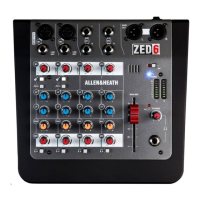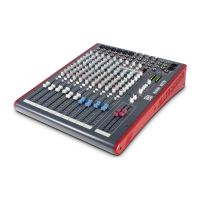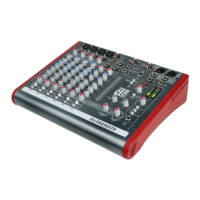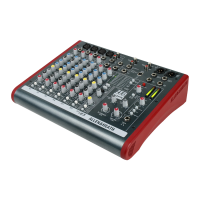8
6.1 Gain Structure
1. Once you’ve connected your instruments and equipment you will need to set input levels
before you can mix the signals together.
2. Gain structure is important to get the maximum signal level, whilst maintaining headroom
and without undesired distortion. Setting gain properly helps to optimise signal quality and
ensure that the signal to noise ratio remains as high as possible (more signal, less noise).
3. If you’re using a microphone make sure the mic is placed at an appropriate distance to the
sound source. Some research on mic placement and experimentation is recommended.
4. Press the PFL switch on the corresponding channel to allow you hear the pre-fader input
signal and show the signal level on the LR Meters.
5. Sing, talk or play your instrument at a typical level of loudness.
6. Slowly turn up the Gain Control on the corresponding channel until you see a good signal
level in the LR Meters. Maximum peaks between “0” and “+6” on the meters are a good
indicator.
7. Connect professional monitoring headphones to the PHONES output and turn up the
PHONES level to a safe listening volume. !
8. Readjust Gain Control for better signal level or to reduce distortion, if necessary. For very
loud sources using channels M3 & M4 with LINE/PAD activated may be required.
Once you’re happy with the input signal level, you may wish to use lo-cut and the EQ to
enhance intelligibility or remove unwanted frequencies and improve the tonal balance of the source sound, so keep
the channel PFL switch enabled for now!
6. Get the best sound
6.2 Shaping Sound
EQ filters audio passing through it and allows you to ‘cut’ (turn down) or ‘boost’ (turn up) selected
frequencies. ‘Boosting’ a frequency too much may cause the signal to clip or distort. ‘Cutting’ a frequency will cause a
reduction in signal level.
Overuse of EQ may cause the sound to be unnatural. Understanding the frequency responses of different instruments
and how they might overlap will help you make good decisions on how to EQ musically.
1. lo-cut (Hi-pass Filter) removes unwanted low frequency noise such as rumble,
handling noise, thumps and proximity effect and helps maintain clarity in the signal.
lo-cut affects both Mic and Line/Inst inputs. The corner frequency is set at
100Hz.
2. HF EQ (High Frequency) affects treble frequencies in the signal. The corner
frequency is at 12kHz for adding “brightness” and “definition” to guitars or for
reducing “hiss” in vocals and “harshness” in cymbals.
3. MF EQ (Mid Frequency) equaliser affects the middle of the frequency range in
the signal. The centre frequency is set at 600Hz for adding “presence” to vocals or
for removing “boxiness” from guitars.
4. LF EQ (Low Frequency) equaliser affects bass frequencies in the signal.
The corner frequency is 80Hz for adding “roundness” and “sub-bass” to bass guitar
or kick drum, or to remove “boom” from toms.
When you’re happy with the input signal level and tone you can disable the channel’s
PFL switch and think about how to mix all these sounds together!
